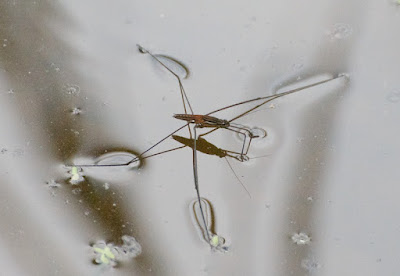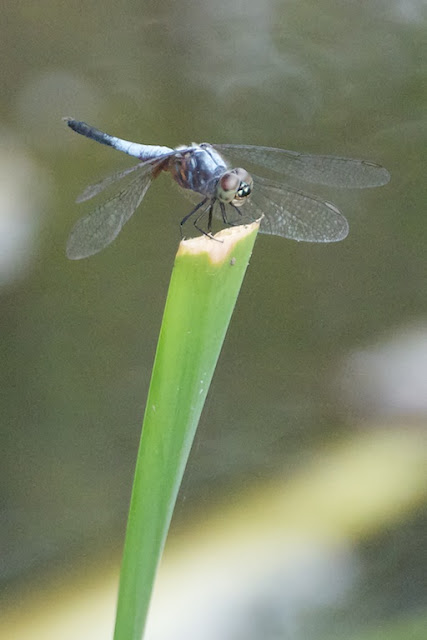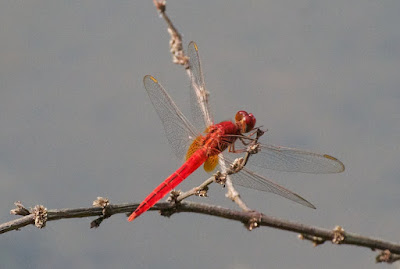We saw so much during our day visit to Sungei Buloh that I have had to break my account of it into two parts. This one is devoted to invertebrates, including the unseen creators of this arboreal termitarium, an object that reminded me of a giant bagworm case (if you are familiar with bagworms).
This nerite appears to have succumbed to something - those tentacle-like projections sticking out from under its shell do not seem to be part of a living snail. The fly waiting nearby seems to agree with me.
Lower down, just above (and below) the water line, barnacles encrust the mangrove roots. Most are probably Acorn Barnacles (Balanus sp.) of various sorts.
Crawling over the mud is a horseshoe crab, either a Mangrove Horseshoe Crab (Carcinoscorpius rotundicauda, more likely) or a Coastal Horseshoe Crab (Tachypleus gigas). These are two of only four surviving species of an ancient lineage. Horseshoe crabs are not, of course, crabs (or crustaceans of any kind), but distant relatives of spiders.
These are true crustaceans, examples of Singapore's forty-odd species of tree-climbing sesarmid crabs.
Sesarmids dig burrows in the mud, surmounted by chimneys that the crabs clamber over as they duck out of sight.
It isn't always easy to identify these crabs from a photograph (well, certainly not for me!) but I think this one is a Pink-fingered Vinegar Crab (Episesarma chengtongense).
These appear to be Violet Vinegar Crabs (Episesarma versicolor). Notice the distinctive white claw-tips.
Insects are generally not as tolerant of brackish water as other arthropods, but we did see water striders skimming over the surface. This appears to be Limnometra ciliata.
In the trees above the water, though, insects become dominant. Pseudagrion microcephalum is one of Singapore's most common damselflies.
We found several common dragonflies in the course of our walk, but not the one dragonfly pretty much confined to mangroves, the rare Raphismia bispina. Instead, we turned up the rather similar - but far more abundant and widespread - Brachydiplax chalybea.
We also found the abundant Neurothemis fluctuans...
...and the almost as common Orthetrum sabina.
More colourful dragonflies included the brilliant Crocothemis servilia...
...the handsome Agrionopteris insignis, a species I only see occasionally...
....one of the commoner of the all-red dragonflies, Rhodothemis rufa (called the Common Redbolt in Singapore)...
...and the particularly showy Rhyothemis phyllis, waving its wings about semaphore-fashion, showing off the striking yellow-and-black patch on its hindwing.
The Blue Glassy Tiger (Ideopsis vulgaris macrina) was one of the showier butterflies we encountered in the mangrove forest. Mangrove forests, indeed, are its main stronghold in Singapore, though it does show up on parks and urban gardens.
Singapore has a number of members of the large, and as far as species identification is concerned extremely difficult, genus Arhopala, the oakblues. This one, if I have identified it correctly based on the metallic greenish borders to the dark spots in the forewing, is the Centaur Oakblue (Arhopala centauris nakula), one of the larger members of the genus (why Johan Christian Fabricius, who described the species back in 1775, decided to name it after the half-horse/half-human monsters of Greek mythology I have no idea). Like other oakblues, its caterpillars and pupae are tended (in return for a sugary solution they secrete) by ants, in this case the Weaver Ant (Oecophylla smaragdina).
This rather ratty little butterfly, presumably nearing the end of its lifespan, is a Dark Caerulean (Jamides bochus nabonassar). A fresh adult is a lot more attractive, especially since its more colourful bits are on the edge of the hindwing - here, mostly torn or abraded away. Its larvae feed on flower buds of certain species of legume, and the butterflies are rarely found far from their host plants.
It is only because there is an excellent photographic guide to the butterflies of Singapore (now in its second edition) that I am able to tell you that this is (probably?) a Lesser Dart (Potanthus omaha omaha).
This unusually colourful little skipper is a Sumatran Sunbeam (Curetis saronis sumatrana), a common species in Singapore's coastal mangroves. Unfortunately, this photo does not show its striking, silvery-white underwings.
These peculiar little insects barely look like butterflies at all. They are, in fact, a mating pair of Pale Mottles (Logania marmorata damis), odd members of the subfamily Miletinae (one of the subfamilies of the gossamerwing, or blue-and-hairstreak, family Lycaenidae). They so engrossed me that I managed to miss a pair of battling Water Monitors (Varanus salvator) only a few feet away, so this photo is as dramatic as this posting will get.
Other insects we came across on our walk through the mangroves included this mantid nymph. There are some twenty species of mantid in Singapore, and I have no idea which one this is.
It may be hard to convince people to admire something called the Oriental Latrine Fly (Chrysomya megacephala), but I find this to be a quite handsome insect (well, as flies go). The big orange eyes are quite striking, in my opinion. Its behaviour does not, however, add to its image: according to Wikipedia, it "infests corpses soon after death". Thanks to accidental introductions, this fly is now widespread in the warmer parts of the world.
This little beetle appears to be a ladybird (Family Coccinellidae) of some sort, and the little creature to its right looks very much like a ladybird larva. Whether they are related, casual acquaintances or predator and meal-to-be, though, I cannot say.
This is a Shield or Stink Bug (Family Pentatomidae), one of a number of colourful Singapore species.
Rather more startling - and unusual - was one of its cousins, the Mangrove Shield Bug (Calliphara nobilis) of the related family Scutellaridae. Though adults may cluster together on almost any large leaf, its larvae are found exclusively on the leaves of a single species of tree, the Buta-Buta (Excoecaria agallocha). The Buta-Buta is a member of the Euphorbiaciae, and like many of its relatives it extrudes a highly toxic latex if a leaf or stem is broken. The larvae, however, are presumably immune to its toxin.
In clusters or on its own, this was one of the most striking insects we found in the mangroves.
In sum (for this post and its predecessor), Sungei Buloh is a splendid place for a naturalist. We had a long and exciting day there (and, as this photo of Ryan, his dad Kevin and their cousin Cynthia demonstrates, an exhausting one!)
...and the particularly showy Rhyothemis phyllis, waving its wings about semaphore-fashion, showing off the striking yellow-and-black patch on its hindwing.
The Blue Glassy Tiger (Ideopsis vulgaris macrina) was one of the showier butterflies we encountered in the mangrove forest. Mangrove forests, indeed, are its main stronghold in Singapore, though it does show up on parks and urban gardens.
Singapore has a number of members of the large, and as far as species identification is concerned extremely difficult, genus Arhopala, the oakblues. This one, if I have identified it correctly based on the metallic greenish borders to the dark spots in the forewing, is the Centaur Oakblue (Arhopala centauris nakula), one of the larger members of the genus (why Johan Christian Fabricius, who described the species back in 1775, decided to name it after the half-horse/half-human monsters of Greek mythology I have no idea). Like other oakblues, its caterpillars and pupae are tended (in return for a sugary solution they secrete) by ants, in this case the Weaver Ant (Oecophylla smaragdina).
This rather ratty little butterfly, presumably nearing the end of its lifespan, is a Dark Caerulean (Jamides bochus nabonassar). A fresh adult is a lot more attractive, especially since its more colourful bits are on the edge of the hindwing - here, mostly torn or abraded away. Its larvae feed on flower buds of certain species of legume, and the butterflies are rarely found far from their host plants.
It is only because there is an excellent photographic guide to the butterflies of Singapore (now in its second edition) that I am able to tell you that this is (probably?) a Lesser Dart (Potanthus omaha omaha).
This unusually colourful little skipper is a Sumatran Sunbeam (Curetis saronis sumatrana), a common species in Singapore's coastal mangroves. Unfortunately, this photo does not show its striking, silvery-white underwings.
These peculiar little insects barely look like butterflies at all. They are, in fact, a mating pair of Pale Mottles (Logania marmorata damis), odd members of the subfamily Miletinae (one of the subfamilies of the gossamerwing, or blue-and-hairstreak, family Lycaenidae). They so engrossed me that I managed to miss a pair of battling Water Monitors (Varanus salvator) only a few feet away, so this photo is as dramatic as this posting will get.
Other insects we came across on our walk through the mangroves included this mantid nymph. There are some twenty species of mantid in Singapore, and I have no idea which one this is.
It may be hard to convince people to admire something called the Oriental Latrine Fly (Chrysomya megacephala), but I find this to be a quite handsome insect (well, as flies go). The big orange eyes are quite striking, in my opinion. Its behaviour does not, however, add to its image: according to Wikipedia, it "infests corpses soon after death". Thanks to accidental introductions, this fly is now widespread in the warmer parts of the world.
This little beetle appears to be a ladybird (Family Coccinellidae) of some sort, and the little creature to its right looks very much like a ladybird larva. Whether they are related, casual acquaintances or predator and meal-to-be, though, I cannot say.
This is a Shield or Stink Bug (Family Pentatomidae), one of a number of colourful Singapore species.
Rather more startling - and unusual - was one of its cousins, the Mangrove Shield Bug (Calliphara nobilis) of the related family Scutellaridae. Though adults may cluster together on almost any large leaf, its larvae are found exclusively on the leaves of a single species of tree, the Buta-Buta (Excoecaria agallocha). The Buta-Buta is a member of the Euphorbiaciae, and like many of its relatives it extrudes a highly toxic latex if a leaf or stem is broken. The larvae, however, are presumably immune to its toxin.
In clusters or on its own, this was one of the most striking insects we found in the mangroves.
In sum (for this post and its predecessor), Sungei Buloh is a splendid place for a naturalist. We had a long and exciting day there (and, as this photo of Ryan, his dad Kevin and their cousin Cynthia demonstrates, an exhausting one!)














































No comments:
Post a Comment